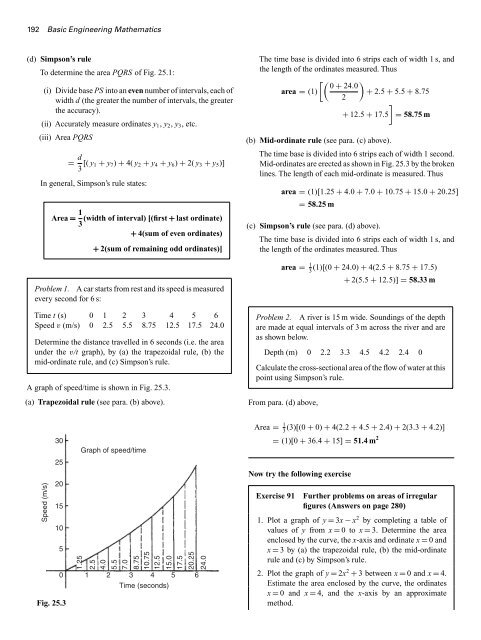basic_engineering_mathematics0
Create successful ePaper yourself
Turn your PDF publications into a flip-book with our unique Google optimized e-Paper software.
192 Basic Engineering Mathematics<br />
(d) Simpson’s rule<br />
To determine the area PQRS of Fig. 25.1:<br />
(i) Divide base PS into an even number of intervals, each of<br />
width d (the greater the number of intervals, the greater<br />
the accuracy).<br />
(ii) Accurately measure ordinates y 1 , y 2 , y 3 , etc.<br />
(iii) Area PQRS<br />
= d 3 [( y 1 + y 7 ) + 4( y 2 + y 4 + y 6 ) + 2( y 3 + y 5 )]<br />
In general, Simpson’s rule states:<br />
Area = 1 (width of interval) [(first + last ordinate)<br />
3<br />
+ 4(sum of even ordinates)<br />
+ 2(sum of remaining odd ordinates)]<br />
Problem 1. A car starts from rest and its speed is measured<br />
every second for 6 s:<br />
Time t (s) 0 1 2 3 4 5 6<br />
Speed v (m/s) 0 2.5 5.5 8.75 12.5 17.5 24.0<br />
Determine the distance travelled in 6 seconds (i.e. the area<br />
under the v/t graph), by (a) the trapezoidal rule, (b) the<br />
mid-ordinate rule, and (c) Simpson’s rule.<br />
A graph of speed/time is shown in Fig. 25.3.<br />
(a) Trapezoidal rule (see para. (b) above).<br />
The time base is divided into 6 strips each of width 1 s, and<br />
the length of the ordinates measured. Thus<br />
[( ) 0 + 24.0<br />
area = (1)<br />
+ 2.5 + 5.5 + 8.75<br />
2<br />
]<br />
+ 12.5 + 17.5 = 58.75 m<br />
(b) Mid-ordinate rule (see para. (c) above).<br />
The time base is divided into 6 strips each of width 1 second.<br />
Mid-ordinates are erected as shown in Fig. 25.3 by the broken<br />
lines. The length of each mid-ordinate is measured. Thus<br />
area = (1)[1.25 + 4.0 + 7.0 + 10.75 + 15.0 + 20.25]<br />
= 58.25 m<br />
(c) Simpson’s rule (see para. (d) above).<br />
The time base is divided into 6 strips each of width 1 s, and<br />
the length of the ordinates measured. Thus<br />
area = 1 (1)[(0 + 24.0) + 4(2.5 + 8.75 + 17.5)<br />
3<br />
+ 2(5.5 + 12.5)] = 58.33 m<br />
Problem 2. A river is 15 m wide. Soundings of the depth<br />
are made at equal intervals of 3 m across the river and are<br />
as shown below.<br />
Depth (m) 0 2.2 3.3 4.5 4.2 2.4 0<br />
Calculate the cross-sectional area of the flow of water at this<br />
point using Simpson’s rule.<br />
From para. (d) above,<br />
Speed (m/s)<br />
30<br />
25<br />
20<br />
15<br />
10<br />
5<br />
Fig. 25.3<br />
1.25<br />
Graph of speed/time<br />
2.5<br />
4.0<br />
5.5<br />
7.0<br />
8.75<br />
10.75<br />
12.5<br />
15.0<br />
0 1 2 3<br />
Time (seconds)<br />
17.5<br />
20.25<br />
24.0<br />
4 5 6<br />
Area = 1 (3)[(0 + 0) + 4(2.2 + 4.5 + 2.4) + 2(3.3 + 4.2)]<br />
3<br />
= (1)[0 + 36.4 + 15] = 51.4 m 2<br />
Now try the following exercise<br />
Exercise 91<br />
Further problems on areas of irregular<br />
figures (Answers on page 280)<br />
1. Plot a graph of y = 3x − x 2 by completing a table of<br />
values of y from x = 0tox = 3. Determine the area<br />
enclosed by the curve, the x-axis and ordinate x = 0 and<br />
x = 3 by (a) the trapezoidal rule, (b) the mid-ordinate<br />
rule and (c) by Simpson’s rule.<br />
2. Plot the graph of y = 2x 2 + 3 between x = 0 and x = 4.<br />
Estimate the area enclosed by the curve, the ordinates<br />
x = 0 and x = 4, and the x-axis by an approximate<br />
method.















![[Lonely Planet] Sri Lanka](https://img.yumpu.com/59845622/1/169x260/lonely-planet-sri-lanka.jpg?quality=85)

